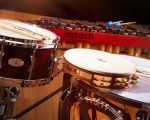Exploring the World of Organ Musical Instruments: A Deep Dive
- 1. What is an Organ Musical Instrument?
- 2. Types of Organ Musical Instruments
- 3. The History of the Organ
- 4. How Does an Organ Work?
- 5. Famous Organists and Their Instruments
- 6. Modern Innovations in Organ Music
1. What is an Organ Musical Instrument?
An organ is a unique and complex musical instrument that produces sound through air passing over pipes or through electronic speakers. It is classified as a keyboard instrument, often found in churches, concert halls, and even in some modern homes. The organ's distinctive sound comes from the manipulation of air, either through pipes or electronically generated tones, and is known for its rich, full-bodied sound that can fill large spaces.
2. Types of Organ Musical Instruments
There are several types of organ instruments, each with its own unique features and history:
2.1 Pipe Organ
The pipe organ is the most traditional and iconic version. It consists of a series of pipes that are controlled by keyboards. Each pipe corresponds to a different note, and air is supplied through them to produce sound. Pipe organs can be incredibly large, with thousands of pipes and multiple keyboards, and are often found in cathedrals and concert halls.
2.2 Electronic Organ
The electronic organ, which became popular in the 20th century, uses electronic circuits to generate sound, mimicking the sound of a pipe organ but without the need for physical pipes. These organs are more compact and versatile, offering a wide range of sounds and effects that are perfect for modern music styles.
2.3 Hammond Organ
Developed in the 1930s, the Hammond organ is a well-known electronic organ used in various genres, including jazz, rock, and gospel. Its distinct sound is produced using an electromechanical method, creating a warm, rich tone that has become iconic in many music styles.
3. The History of the Organ
The history of the organ dates back to ancient Greece, where the first known organ, the hydraulis, was created. It used water pressure to push air through pipes. However, the modern organ as we know it today evolved in Europe during the Middle Ages and Renaissance. It became a central instrument in religious settings, particularly in cathedrals and churches. Over the centuries, the organ has undergone numerous innovations, including the development of pedals, multiple keyboards, and the ability to play more complex compositions.
4. How Does an Organ Work?
At its core, an organ works by controlling the flow of air over pipes (in the case of a pipe organ) or through electronic circuits (in the case of an electronic organ). When a key is pressed, it either opens a valve that allows air to flow through a pipe or triggers an electronic sound generator. The complexity of the organ comes from the multitude of keys and stops, which allow the player to control not just the pitch, but also the timbre and volume of the sound. The organist can combine different sounds, creating rich, layered music that is unique to the instrument.
5. Famous Organists and Their Instruments
Throughout history, many renowned musicians have made their mark as organists. One such figure is Johann Sebastian Bach, whose compositions for the organ are still considered some of the finest ever written. Today, famous organists like Cameron Carpenter continue to innovate and push the boundaries of organ music, often performing on custom-built organs that showcase the latest in organ technology.
6. Modern Innovations in Organ Music
In recent years, the organ has seen several innovations that have made it more accessible and versatile. Digital organs have become more advanced, with features that allow musicians to replicate the sounds of multiple instruments. Some organs even come with built-in synthesizers, allowing performers to experiment with a wide variety of sounds. These innovations have made the organ more adaptable to modern musical genres, including pop, rock, and electronic music.








